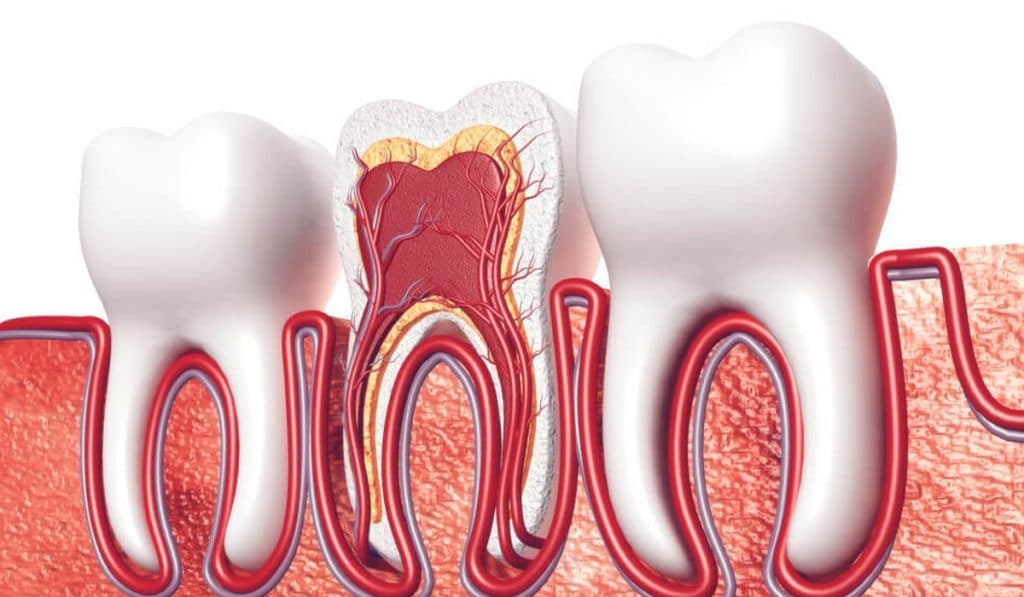Root Canal Treatment in Dubai
The tooth is the hardest element in the human body. It performs several essential functions. Apart from chewing food, tooth also plays a crucial role in speech and provides shape to the face. The framework of the tooth is broadly composed of two parts – the root and the crown. The root firmly holds the tooth in place and is deep inside the jawbone, while the crown part is what we see.
In medical terms, the enamel is the uppermost layer, dentin is the second layer, and pulp is the third layer which consists of blood vessels, nerves, and connective tissue. The pulp helps in the growth of the root of your tooth. Sometimes, the pulp dies when it is diseased and fails to repair itself. The pulp disease can be caused by tooth decay, repeated dental procedures, a crack in the tooth, and large fillings. A tooth with an injured or damaged pulp can be treated with a Root Canal Treatment (RCT).
What is a Root Canal Treatment?
RCT is also known as Endodontic Treatment. It is a treatment performed on a tooth with an injured or inflamed pulp, thereby saving the tooth from extraction. Damaged pulp tissue develops inflammation and increases the growth of bacteria. It can further lead to abscess formation. An abscess is a gap filled with pus towards the end of the roots of the infected tooth. If left untreated, it can cause severe pain and discomfort.
Root Canal Treatment is performed to extract the damaged and inflamed pulp from the root canals. The procedure carefully cleans the area inside of the root canals using special tools. Once the area is free of infection, it is filled with a special sealing material. And later, a dental crown is placed on the area such that the tooth functions normally.
How do you know if you need a root canal?
A thorough examination and evaluation, along with an X-ray of the tooth area, is required for accurate assessment and diagnosis. However, several symptoms to watch for include:
- Tooth pain
- Persistent sensitivity to heat and cold
- Discomfort while eating
- Swelling of gums
- Pus in gums
- Cracked or chipped tooth
If you notice these symptoms, consult a dentist to prevent any emergency.
What are the steps of root canal treatment?

RCT may be done in a single sitting or several sittings, depending on the complexity of the case. The number of visits may range from two to four. The anesthetic injection is given before starting the procedure. Your doctor will discuss with you the time, duration, complications, and outcome before starting the treatment. Detailed steps of the process are discussed below:
- An X-ray will be taken to see the infection and size of the root canals.
- Local anesthesia is given to you through an injection to numb the infected area.
- A hole is made in the tooth using a drill.
- The respective root canals and the pulp chamber are cleaned using special instruments called root canal files.
- Antibacterial and antiseptic solutions are used to disinfect the canals and clean the debris.
- The canals are given a shape to hold the filling material.
- The sealing material is then heated and sealed using medical instruments.
- If the tooth fails to hold the structure, your doctor may place a screw inside the tooth to hold the restoration.
- Lastly, a crown is placed for the normal functioning of the tooth.
Is the treatment painful?
The entire procedure in itself is generally painless. Most RCT procedures are conducted under local anesthesia. This is given to you by injection in your mouth. It’s normal to feel some pinch in the area where the needle touches your mouth. The doctor starts the procedure only after the tooth gets numb. In certain cases, an anesthetic injection may not be necessary at all.
However, you might feel numbness in the respective area after the procedure. It may cause mild discomfort initially.
Do you always need a crown after a root canal?
Root Canal Treatment is required on the tooth that has substantial decay, large fillings, and other defects. It becomes quite vulnerable too. Due to these reasons, you may need a crown or cap to protect it from breaking, restore it, and bring it back to full function. In some cases, a crown is required but may not be mandatory.
The crown is typically made from metal, porcelain, or ceramic material. It protects the top of the tooth and helps avoid infection by providing support and structure to the tooth.
How long can you delay getting a crown after a root canal?
After the treatment, approximately you may wait for 1-2 weeks before the crown is placed. Crown placement is the final step of the endodontic treatment.
Throughout this time, consume softer foods to avoid damage to your tooth. Also, rinse your mouth with warm salt water to flush out any food particles.
What are the advantages of root canal treatment?
The following are convincing reasons to go for root canal treatment:
- Treats the decaying tooth by eliminating the infection
- Relief from discomfort and pain
- Saves the natural tooth from extraction
- No diet restriction
- Retains the natural smile with a cosmetically appealing dental crown
- The preserved tooth may last a lifetime
- Costs less as compared to the tooth extraction procedure
- Shorter recovery time


What are the side effects of Root Canal Treatment?
- If the infected material is left behind, it can cause abscess formation and may attract bacteria. Bacteria might also spread to other parts of the body causing new infection.
- If the damage or infection is too deep to undergo the procedure, you might have to get the tooth extracted.
- To ease out the pain, antibiotics are prescribed after the procedure. The use of antibiotics has its own disadvantages and side effects.
Can root canal treatment be avoided?
The pulp of the tooth becomes inflamed due to several reasons like tooth decay, infection, repetitive dental procedures, and a chip or crack in the tooth. You may reduce the chances to go for RCT by practicing good oral hygiene. Few measures you can take include regular flossing, brushing twice a day, and visits to your dentist. It is important for kids to visit dentist regularly.
The only other option is to get the infected tooth extracted. It will be then replaced with an implant, bridge, or detachable partial denture. This is done for aesthetics, to restore it to its full functioning, and avoid adjacent teeth from moving. This method is not only more expensive than a root canal procedure but also requires more time.
How much does a root canal cost in Dubai?
The cost of RCT in Dubai depends on which tooth is affected and the complexity of the problem. Usually, the RCT of the anterior teeth costs less than the posterior teeth. This is due to the complicated framework of the root canal system.
Typically, the restoration and endodontic treatment cost less when compared to the tooth extraction procedure. After tooth removal, it must be replaced with a bridge or an implant for aesthetics and normal functioning, which adds to the cost.
Why 7DMC for RCT?
We, at 7DMC, perform one of the best root canal procedures in Dubai. With our trained and expert dentists, it is a pain-free process at our clinic. We understand the risks and dangers involved in the process, hence we use the latest technology and advanced equipment to perform the procedure. We ensure that our patients are comfortable and relaxed before the procedure starts. The entire process is performed with precision to treat and save your natural tooth.
For further details, call us to book an appointment.
Summary
RCT is designed to eliminate bacteria from the root canal, prevent re-infection, and save the tooth from extraction. Preserving your natural teeth is the best way, if possible. Your natural tooth allows you to eat a variety of foods that are essential to maintain adequate nutrition. The root canal procedure helps you save your natural tooth.
Root canal treatment is extremely successful. In no time, you will be back to chewing, biting, and smiling with ease. In most cases, the treated tooth can function normally for a lifetime.
References
https://www.webmd.com/oral-health/guide/dental-root-canals#1
aae.org/patients/root-canal-treatment/what-is-a-root-canal
https://www.healthline.com/health/root-canal
- CATEGORIES : Dental




